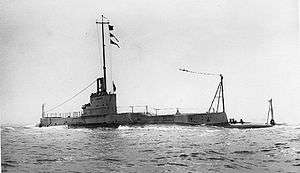HMS Rainbow (N16)
  HMS Rainbow at sea, bow and stern images | |
| History | |
|---|---|
| Name: | HMS Rainbow |
| Ordered: | 28 January 1929 |
| Builder: | Chatham Dockyard |
| Laid down: | 24 July 1929 |
| Launched: | 14 May 1930 |
| Commissioned: | 18 January 1932 |
| Identification: | Pennant number: N16 |
| Fate: | Believed sunk on 4 October 1940 |
| General characteristics | |
| Class & type: | Rainbow-class submarine |
| Displacement: |
|
| Length: | 287 ft (87 m) |
| Beam: | 30 ft (9.1 m) |
| Draught: | 16 ft (4.9 m) |
| Propulsion: |
|
| Speed: |
|
| Complement: | 53 |
| Armament: |
|
HMS Rainbow was a Rainbow-class submarine built for the Royal Navy during the 1930s.
Design and description
The Rainbow-class submarines were designed as improved versions of the Parthian class and were intended for long-range operations in the Far East. The submarines had a length of 287 feet 2 inches (87.5 m) overall, a beam of 29 feet 10 inches (9.1 m) and a mean draft of 13 feet 10 inches (4.2 m). They displaced 1,772 long tons (1,800 t) on the surface and 2,030 long tons (2,060 t) submerged. The Rainbow-class submarines had a crew of 56 officers and ratings. They had a diving depth of 300 feet (91.4 m).[1]
For surface running, the boats were powered by two 2,200-brake-horsepower (1,641 kW) diesel engines, each driving one propeller shaft. When submerged each propeller was driven by a 660-horsepower (492 kW) electric motor. They could reach 17.5 knots (32.4 km/h; 20.1 mph) on the surface and 9 knots (17 km/h; 10 mph) underwater. On the surface, the boats had a range of 7,050 nautical miles (13,060 km; 8,110 mi) at 9.2 knots (17.0 km/h; 10.6 mph) and 62 nmi (115 km; 71 mi) at 4 knots (7.4 km/h; 4.6 mph) submerged.[1]
The boats were armed with six 21-inch torpedo tubes in the bow and two more in the stern. They carried six reload torpedoes for a grand total of fourteen torpedoes. They were also armed with a QF 4.7-inch (120 mm) Mark IX deck gun.[2]
Construction and career
Rainbow served in the Far East until 1940. She left for a patrol off Calabria on 23 September 1940 [3] and was due to be back in Alexandria on 16 October, she was last heard from on 25 September. She is believed to have been sunk on 4 October in a collision with the Italian merchant ship, Antonietta Costa, which reported striking an underwater object at 03:30, followed by a huge underwater explosion on that date.[4]
Until 1988 it was believed that she had been sunk by Italian submarine Enrico Toti, the sunken ship was eventually determined to be HMS Triad (N53).[3]
Notes
References
- Akermann, Paul (2002). Encyclopaedia of British Submarines 1901–1955 (reprint of the 1989 ed.). Penzance, Cornwall: Periscope Publishing. ISBN 1-904381-05-7.
- Bagnasco, Erminio (1977). Submarines of World War Two. Annapolis, Maryland: Naval Institute Press. ISBN 0-87021-962-6.
- Colledge, J. J.; Warlow, Ben (2006) [1969]. Ships of the Royal Navy: The Complete Record of all Fighting Ships of the Royal Navy (Rev. ed.). London: Chatham Publishing. ISBN 978-1-86176-281-8. OCLC 67375475.
- Chesneau, Roger, ed. (1980). Conway's All the World's Fighting Ships 1922–1946. Greenwich, UK: Conway Maritime Press. ISBN 0-85177-146-7.
- McCartney, Innes (2006). British Submarines 1939–1945. New Vanguard 129. Oxford, UK: Osprey. ISBN 1-84603-007-2.